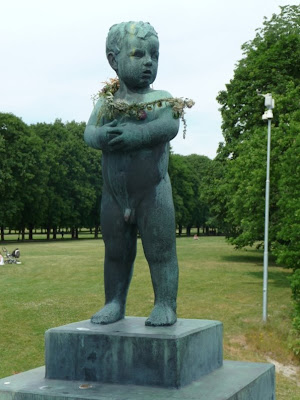Spiterstulen is an unpretentious but very nice lodge/cabins/hostel/campground place 20km up from Lom, set between Norway's two big mountains, Glitterlind and Galdhopiggen. It is a jumping off point for a variety of hikes, treks and climbs. And it is alpine country, 1100 meters, but already above tree-line at this latitude, and surrounded by snowy peaks and glaciers and torrential creeks and rivers of glacier-milky water. It is a terrain more akin to Denali than anything else I can remember.
There are two standard routes up the big mountain, Galdhopiggen. The more popular is via Juvasshytta, at 1800 meters, where, in a group, you rope-up, and a guide leads you across the glacier, like a tour bus, and then up a ridge to the summit. Being cheap, independent, anti-social, slow, etc., I elected the second route, longer and steeper, but no group and no guide, from Spiterstulen. We don't need no stinking guides.
From Spiterstulen, Galdhopiggen is described as a day-hike, and indeed it is, but a very long one, at least early in the season with so much snow. I left the camper at 8AM, reached the summit at 4, very late, and got back down only by 10PM. It was about a 4,500 foot climb, by my reckoning, one of the longest I have ever done, both up and back, in a day. The first thousand feet or so was trail and then talus, and then, talus and boulder-hopping. After that, most of the way, it was mixed snow and boulder-hopping, mostly snow. The snow was deep and slower-going, but the consequences of slipping, as I did many times (my boots are environment-friendly, with not very aggressive lugs), were far less than on rock, particularly where the boulders formed a knife-edge over the glaciers below. There were several high points, but the true summit came into view only about 2PM. (I had begun to wonder why all the parties that had passed me on the way up were not passing me now on the way back down). I slugged on, sending word back to Vicki at the camper that I would be late returning.
What I thought was a summit refuge turned out to be a summit cafe. See pix. What is this, France? I bought a souvenir, had a cup of coffee, signed the register, closed the place, then took pix all around, and felt very good about making yet another significant summit. Persistence, determination, calculation, etc. The alpine surroundings were incredible, more like Alaska than anything else I can remember. It was glorious, in every direction.
Then I remembered I had to get back down. Another six hours of trudging, light failing, wind picking up, getting cooler....
At length, I made it back down, slipping and sliding more than I would have liked, but nothing serious except a bit of sun-burn. On the way I helped a Norwegian family find its daughter's sunglasses in a boulder-field. Who can resist making a ten-year-old happy? I hope she will think well of Americans.
Vicki was properly unhappy with me when I got back. 14 hour stress tests are not what a 62 year old should be doing. She is right, of course. As always. But I'd do it again. Day
after tomorrow.

Upper reaches of the route from Spiterstulen; I
have no pix of the mountain proper--it's pretty isolated

Final push to the summit

Summit view

Bergschrund on a glacier below

Distant view from summit


















































